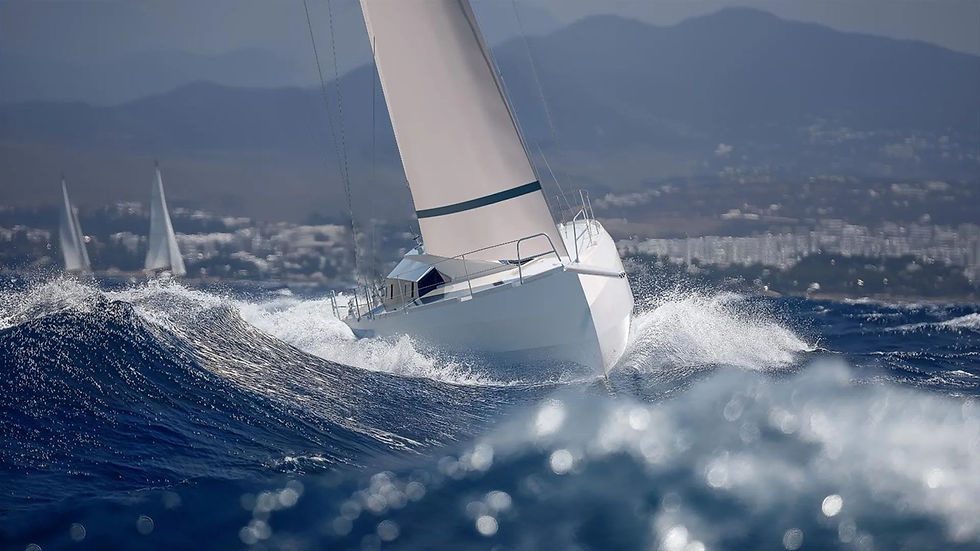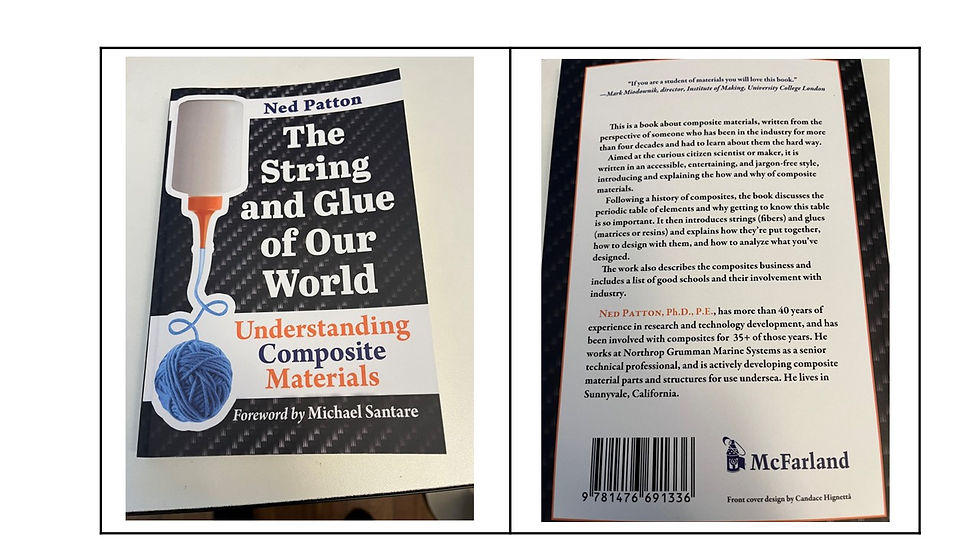Some Encouraging News in Carbon Fiber Composites Recycling – and a Few Other Things
- Ned Patton

- Jul 23
- 8 min read
I saw something really interesting that was just reported in Composites World. There is a new article in Nature (1) written by some researchers at NREL where they discovered that hot acetic acid will dissolve nearly all epoxies that are currently in use in carbon fiber composites. This includes the most common ones, the aliphatic resins such as polyesters and vinyl esters as well as aromatic resins such as the most common of all – Bisphenol-A based resins. These are the most commonly used resins in carbon fiber composites and have been for the last 40 years or so.

Yes, that’s hot concentrated vinegar folks, which is cheap, easy to come by, and is most commonly produced from fermenting plant sugars to make ethanol, and then allowing another bacterium to convert the alcohol to vinegar. I’m sure you have some vinegar in your kitchen and those of you that eat salads probably have your favorite. Mine is aged balsamic from the region of Italy where they grow the right grapes to make their vinegar.
The article in Nature (reference 1) provides some of the process parameters for this, but the basic approach is to soak chopped up end of life carbon fiber composites in hot acetic acid for 2 hours. What the NREL researchers were able to demonstrate is that they got pristine carbon fibers with little to no resin residue, and the hot acetic acid bath had dissolved polymers in it that were still basically intact resin precursors. So what the acetic acid does is to undo all of the cross links in the cured resins and leave behind clean carbon fiber and organics that can be easily converted in to new resin to make new composites.
While this is still very much a research-style batch process, the results that the NREL researchers got is very intriguing and could be at least part of the answer of what to do with our aging carbon fiber composites. And, while this was focused on carbon fiber composites, it may also be a viable approach to recycling glass fiber composites.
The NREL researchers were working on the BOTTLE project (Bio-Optimized Technologies to keep Thermoplastics our of Landfills and the Environment) which is a consortium of laboratories and universities funded by the Department of Energy which includes the likes of two different parts of NREL, Oak Ridge National Lab, Argonne, Colorado State, MIT, Northwestern, U of Wisconsin, and the University of Puerto Rico. The BOTTLE project was conceived to develop catalytic and biocatalytic recycling strategies that are able to break down current plastics and plastic waste into reusable polymers that can be used to make new plastics. This is part of the Department of Energy’s and specifically NREL’s goal of creating a circular economy for one of the most challenging sustainability problems that we face today – plastic waste. It appears that they have come up with a rather innovative solution at least to the cured resins problem in composites. And it is simple, effective, cheap, and results in pristine fibers and reusable organic resin precursors.
In other news, there is another development on the recycling front that demonstrates that the Europeans are dead serious about circularity and sustainability in the composite materials business. Northern Lights Composites (NLComp), a startup in Italy that I have written about in the past, has broken ground on a new facility to scale up their sustainable composite products that they call rComposite. There are several versions of this stuff, all of which use either natural fibers (flax), recycled glass fibers, recycled carbon fibers, and recycled PET (plastic soda bottles) made into flotation foam, or a combination of some or all of these.
NLComp started as a racing sailboat manufacturer and decided some time ago to transform their operations to become a fully sustainable yacht builder. Part of the impetus from this of course came from the European Green New Deal which was enacted into law a few years back that requires that pleasure boat hull manufacturers account for and handle recycling and reuse of the used boat hulls in the cost of manufacturing them. NLComp has taken this a bit further than most in that they have been working with recyclable resin companies (Arkema and their Elium® resins), Composite Recycling with their recycled glass fiber, and Veolia with their experience in recycling of plastics, specifically to source their PET to create a sustainable and circular material specifically tailored for the racing sailboat industry.
Their first product will be a new racing sailboat, the Offshore 34. This boat is the first high performance, large cruiser racer to come out as a Northern Lights boat. Previously, they have made sailing dinghies, yacht tenders, and some smaller boats, so this is the first larger production boat that will carry the Northern Lights name.

This facility that is being built by Northern Lights in Monfalcone, Italy, close to NLComp’s headquarters is a total of 500 square meters (about 5000 square feet) and will host a production line for parts that are as long as 20 meters (about 200 feet), so they will have plenty of production capacity to build the Offshore 34 in this facility. Monfalcone is a province in the Northeast of Italy along the Gulf of Trieste, nearly on the border with Slovenia. So, this is part of the industrial heartland of Italy.
NLComp is calling this facility their first rFactory and have apparently secured as much as €1.2 million (about $1.4M) in venture backed funding to build this facility, so they apparently have strong backing from the European investment community. This is a good sign because since this is not EU funded, but privately venture backed, they must have a very good business plan as well as a very good track record of financial success.
Finally, in the weird and wonderful world of wind energy, and people with what had seemed to be crazy ideas, comes a demonstration from the University of Glasgow of a bladeless wind turbine. First thing I asked myself was how do they do that? Well, it turns out that they actually used the elastic properties and light weight of carbon fiber composites to do it. In an article from the American Composite Manufacturers Association’s Composites Manufacturing magazine (2), researchers from the University of Glasgow’s James Watt School of Engineering report on the results of a study into bladeless wind turbines. What they came up with is surprising and could very easily be implemented on a broad scale in urban environments because it is noiseless and has a very small footprint for the power output. On top of that it is completely passive – as in when the wind blows these things will generate electricity.

The idea they came up with is to have a tall, fairly fat cylinder attached to a stalk of carbon fiber composite that is mounted to a device that generates electricity when the tall cylinder sways back and forth in the wind. This is called vortex induced vibration and is one of those things that aircraft designers and wind turbine blade designers avoid as much as possible, primarily because of blade root fatigue. But that is exactly what these researchers were looking for. Si they did thousands of simulations of these devices using different size and shape cylinders in 20 to 70 mph winds and discovered that there is a “sweet spot” in the size that gets you to a steady state of vortex induced vibration that has the potential to produce as much as a kilowatt of electricity in real world conditions while maintaining structural integrity of both the tall fat cylinder and the carbon fiber post that it sits on.
While this is just a laboratory study, it does show that there is potential for this technology. They are still working on it to try to refine the materials, possibly using a meta-material solution for the cylinder and the post to optimize the output and longevity of these things. And of course this needs to be scaled up and a cost/benefit analysis still needs to be done before anyone will start implementing this, but maybe once it is scaled up and these things are cheap enough, put a few of these on top of every building in an urban environment and you could potentially power most of a city.
That’s about it for this week, and it is about time I got off this soap box anyway. As always, I hope everyone that reads these posts enjoys them as much as I enjoy writing them. I will post this first on my website – www.nedpatton.com – and then on LinkedIn. And if anyone wants to provide comments to this, I welcome them with open arms. Comments, criticisms, etc. are all quite welcome. I really do want to engage in a conversation with all of you about composites because we can learn so much from each other as long as we share our own perspectives. And that is especially true of the companies and research institutions that I mention in these posts. The more we communicate the message the better we will be able to effect the changes in the industry that are needed.
I also wanted to mention that I will be giving a talk and chairing a session at the ICCM conference (International Conference on Composite Materials) at the Baltimore Convention Center on August 8 if anyone plans on being there. It is being hosted by my alma mater, the University of Delaware to celebrate the 50th anniversary of the founding of the Center for Composite Materials. That’s where I did my doctoral work so I know several of the people who are going to be at the conference. Should be fun.
I also have some news about my second book. It has appeared in the McFarland Fall Catalog for presale - https://mcfarlandbooks.com/product/Sustainable-Composite-Materials/. As I have mentioned before, this book is a roadmap to a circular and sustainable business model for the industry which I hope that at least at some level the industry will follow. Only time will tell. Since my publisher and I have finally come to agreement about the title for my next book, our daughter has been kind enough to put together a draft of the cover of the book for them to use to come up with a final version. So, I’ve included the approved cover at the end of this post as promised. Let me know whether or not you like the cover. Hopefully people will like it enough and will be interested enough in composites sustainability that they will buy it. And of course I hope that they read it and get engaged. We need all the help we can get.
Last but not least, I still need to plug my first book, so here’s the plug. The book pretty much covers the watershed in composites, starting with a brief history of composites, then introducing the Periodic Table and why Carbon is such an important and interesting element. The book was published and made available last August and is available both on Amazon and from McFarland Books – my publisher. However, the best place to get one is to go to my website and buy one. I will send you a signed copy for the same price you would get charged on Amazon for an unsigned one, except that I have to charge for shipping. Anyway, here’s the link to get your signed copy: https://www.nedpatton.com/product-page/the-string-and-glue-of-our-world-signed-copy. And as usual, here are pictures of the covers of both books.





Comments